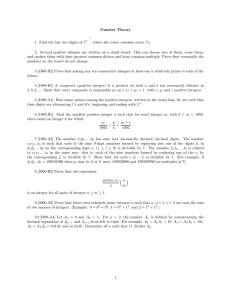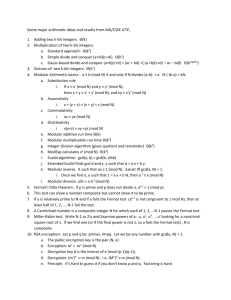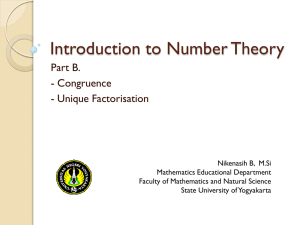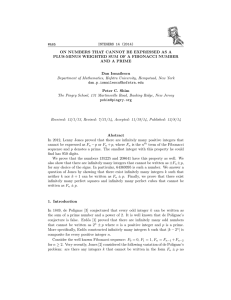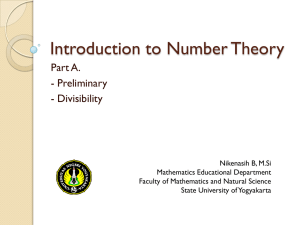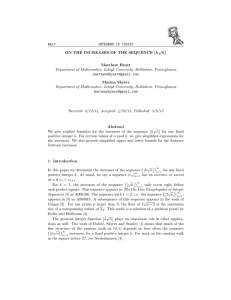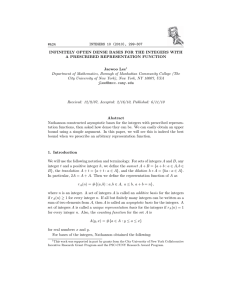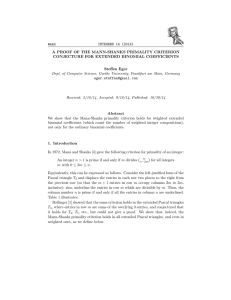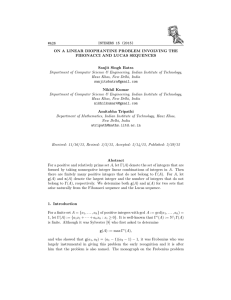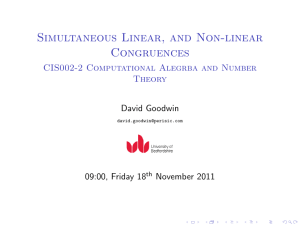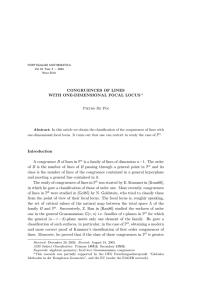MATH 433 Applied Algebra Lecture 6: Congruences (continued).
advertisement
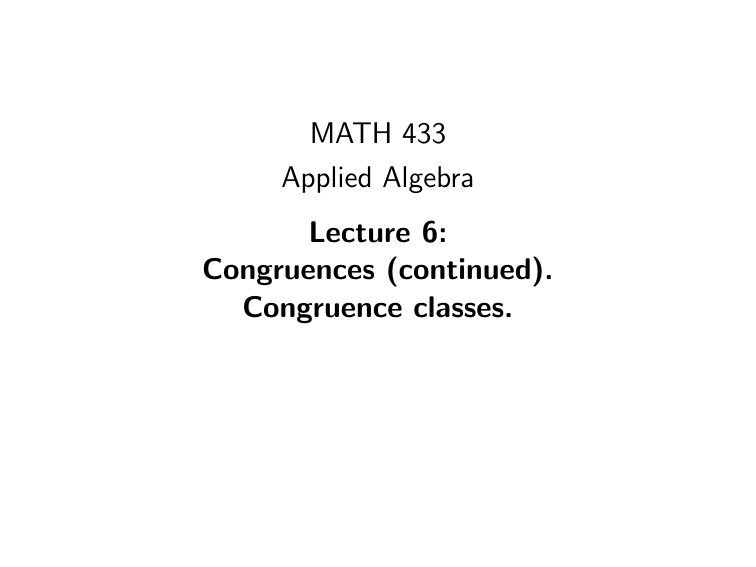
MATH 433
Applied Algebra
Lecture 6:
Congruences (continued).
Congruence classes.
Congruences
Let n be a positive integer. The integers a and b
are called congruent modulo n if they have the
same remainder when divided by n. An equivalent
condition is that n divides the difference a − b.
Notation. a ≡ b mod n or a ≡ b (mod n).
Proposition If a ≡ b mod n then for any c ∈ Z,
(i) a + cn ≡ b mod n;
(ii) a + c ≡ b + c mod n;
(iii) ac ≡ bc mod n.
More properties of congruences
Proposition If a ≡ a0 mod n and b ≡ b 0 mod n,
then (i) a + b ≡ a0 + b 0 mod n;
(ii) a − b ≡ a0 − b 0 mod n;
(iii) ab ≡ a0 b 0 mod n.
Proof: Since a ≡ a0 mod n and b ≡ b0 mod n, the number n
divides a − a0 and b − b0 , i.e., a − a0 = kn and b − b0 = `n,
where k, ` ∈ Z. Then n also divides
(a + b)−(a0 + b0 ) = (a − a0 )+(b − b0 ) = kn + `n = (k + `)n,
(a − b)−(a0 − b0 ) = (a − a0 )−(b − b0 ) = kn − `n = (k − `)n,
ab − a0 b0 = ab − ab0 + ab0 − a0 b0 = a(b − b0 )+(a − a0 )b0
= a(`n) + (kn)b0 = (a` + kb0 )n.
Primes in arithmetic progressions
Theorem There are infinitely many prime numbers
of the form 4k + 3, k ∈ Z.
Idea of the proof: Let p1 , p2, . . . , pn be primes
different from 3 and satisfying pi ≡ 3 mod 4.
Consider the number N = 4p1p2 · · · pn + 3. This
number must have a prime divisor p ≡ 3 mod 4.
Note that p is different from p1 , p2, . . . , pn and 3.
Theorem (Dirichlet) Suppose a and d are
positive integers such that gcd(a, d ) = 1. Then
the arithmetic progression a, a + d , a + 2d , . . .
contains infinitely many prime numbers.
Divisibility of decimal integers
Let dk dk−1 . . . d3 d2 d1 be the decimal notation of a positive
integer n (0 ≤ di ≤ 9). Then
n = d1 + 10d2 + 102 d3 + · · · + 10k−2 dk−1 + 10k−1 dk .
Proposition 1 The integer n is divisible by 2, 5 or 10 if and
only if the last digit d1 is divisible by the same number.
Proposition 2 The integer n is divisible by 4, 20, 25, 50 or
100 if and only if d2 d1 is divisible by the same number.
Proposition 3 The integer n is divisible by 3 or 9 if and only
if the sum of its digits dk + · · · + d2 + d1 is divisible by the
same number.
Proposition 4 The integer n is divisible by 11 if and only if
the alternating sum of its digits
(−1)k−1 dk + · · · + d3 − d2 + d1 is divisible by 11.
Hint: 10m ≡ 1 mod 9, 10m ≡ 1 mod 3, 10m ≡ (−1)m mod 11.
Problem. Determine the last digit of 72015.
The last digit is the remainder under division by 10.
We have 71 ≡ 7 mod 10 and 72 = 49 ≡ 9 mod 10.
Then
73 = 72 · 7 ≡ 9 · 7 = 63 ≡ 3 (mod 10).
Further,
74 = 73 · 7 ≡ 3 · 7 = 21 ≡ 1 (mod 10).
Now it follows that 7n+4 ≡ 7n mod 10 for all n ≥ 1.
Therefore the last digits of the numbers
71, 72, 73, . . . , 7n , . . . form a periodic sequence with
period 4. Since 2015 ≡ 3 mod 4, the last digit of
72015 is the same as the last digit of 73, which is 3.
Problem. When the number 147 · 2530 · 4012 is
written out, how many consecutive zeroes are there
at the right-hand end?
The number of consecutive zeroes at the right-hand end is the
exponent of the largest power of 10 that divides our number.
As follows from the Unique Factorisation Theorem, a positive
integer A divides another positive integer B if and only if the
prime factorisation of A is part of the prime factorisation of B.
The prime factorisation of the given number is
147 · 2530 · 4012 = (2 · 7)7 · (52 )30 · (23 · 5)12 = 243 · 572 · 77 .
For any integer n ≥ 1 the prime factorisation of 10n is 2n ·5n .
Hence 10n divides the given number if n ≤ 43 and n ≤ 72.
The largest number with this property is 43. Thus there are
43 zeroes at the right-hand end.
Congruence classes
Given an integer a, the congruence class of a modulo n is
the set of all integers congruent to a modulo n.
Notation. [a]n or simply [a]. Also denoted a + nZ as
[a]n = {a + nk : k ∈ Z}.
Examples. [0]2 is the set of even integers, [1]2 is the set of
odd integers, [2]4 is the set of even integers not divisible by 4.
If n divides a positive integer m, then every congruence class
modulo n is the union of m/n congruence classes modulo m.
For example, [2]4 = [2]8 ∪ [6]8 .
The congruence class [0]n is called the zero congruence
class. It consists of the integers divisible by n.
The set of all congruence classes modulo n is denoted Zn .
It consists of n elements [0]n , [1]n , [2]n , . . . , [n−1]n .
